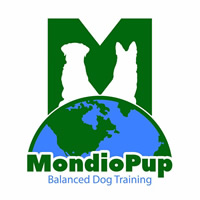Have We All Forgotten About The Leash?
As of late I’ve been seeing that many training programs have eliminated teaching dogs and owners the benefit of leash training. Instead they use food in a variety of different ways to get dogs to perform behaviors in what can best be described as trick training. While a good training program incorporates all of a dog’s valuable resources, including food, it is my opinion that leaving out leash training is a huge mistake. Especially worrisome are the trainers who then incorporate aversive methods without giving the dog directional leash guidance.
The version of "positive reinforcement training" that is most popular today is really hard to do well by the average dog owner. Even with a good instructor, it takes a long time of working really hard to understand how to do that kind of work. Years of time. It's so easy to get it wrong. A dog starts barking/spinning/jumping inside the home in response to something outside the home. The owner waits for the dog to pause for a second, they click and reward. Even if the timing is perfect, this method is bound to fail. Not only has the dog not been given information when it was needed, but the dog started a cycle of undesirable behavior that ended in a reward.
Make no mistake, we use food in training, but we move the work over to the leash and spend a good amount of time working the dog on one. Food is used in the initial stages of learning, but a dog will rarely be reliable with real world distractions on click and treat training alone. There are so many nuances to this type of work when it is done right. Should anyone tell you "if they can teach killer whales with clicker training, it should certainly work for a dog" keep in mind that these creatures are kept in small tanks and have no other choice but to participate if they want to eat. The average family pet has FAR more freedom of choice and outside influences than a dolphin living in a tank or a tiger living in a pen.
However, it's far more commercially viable to sell these methods than to keep it simple with a leash. They've got a treat buyer for life, who may never achieve their goals but who feels good about handing out rewards through months or years of training classes. After all, most people get a dog because it feels good to nurture another being. It's a home run for these training companies that get to sell you their stuff and do not need to even use qualified dog trainers, because the methods will never work anyway.
Skilled trainers teach the use of leash pressure in addition to other components of a dog's training. The tactile nature of a leash provides directional information and makes it very easy to see where and when the dog has yielded to this information. In fact, it's easier for both ends of the leash to understand in this way. Taught once, over a series of lessons, an owner would be well on their way to success with their dog. Teaching a dog on a leash the right way is gentle, clear and fair. The leash will always be a part of your dog’s life. Learning how to properly hold the leash and how to use it to give information to your dog is critical part of the training process.
In general, how training is done will vary based on goals. While the methods used are the same: teach first with food, then with a leash, then with an electronic collar if desired, and then proofed through distractions; depending on the goal for the dog the length of time spent in each of those areas will vary. The sport dog whose owner has IGP or mondio world championships in mind will spend far more time in the food phase of training than the pet dog in the average family home. The average pet dog should spend the majority of time learning with the leash. Simply controlling a dog on a leash means the dog is prevented from making mistakes that will inevitably become undesirable habits.
It's time to rethink "reward based training" methods for the average pet dog, and the possibility that this type of training is not only ineffective but potentially dangerous. Perhaps we need to reframe the idea that a reward is handing your dog a piece of food. Maybe the real reward is in the freedom that comes with reliable training, and in the power of the relationship that is formed by holding your dog accountable for the behaviors you have taught him with clear and fair techniques.
Barkley during the process of transitioning from a long line to remote collar, in just one example of how leashes are used in training.

